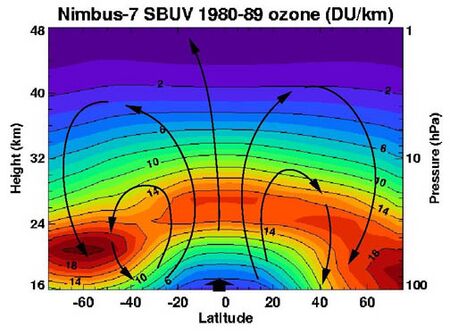Earth:Brewer–Dobson circulation

Brewer–Dobson circulation refers to the global atmospheric circulation pattern of tropical tropospheric air rising into the stratosphere and then moving poleward as it descends.[1] The basics of the circulation were first proposed by Gordon Dobson[2][3] and Alan Brewer.[4] The term "Brewer–Dobson circulation" was first introduced in 1963.[5] This circulation pattern explains observations of ozone and water vapor distribution, and has been accelerating in recent decades, likely due to climate change.[6]
Circulation
Brewer–Dobson circulation is driven by planetary scale atmospheric waves, namely Rossby waves, with results in westward drag and therefore poleward pumping action to conserve angular momentum.[1]
Global impacts
Because it moves air into and out of the stratosphere, Brewer–Dobson circulation determines the mean age and residence time of stratospheric gases, as well as tropical tropopause temperatures and stratospheric water vapor.[1] Brewer–Dobson circulation directly impacts the distribution and abundance of stratospheric ozone by moving it from the tropics towards the poles.[1] This transport helps to explain why tropical air has less ozone than polar air, even though the tropical stratosphere is where most atmospheric ozone is produced.[1] Brewer–Dobson circulation also influences the lifetime of ozone-degrading substances and some greenhouse gases.
Acceleration due to greenhouse effect
Interest in Brewer–Dobson circulation has increased in the 21st century due to predictions of general circulation models and chemistry-climate models that the circulation will accelerate due to greenhouse-gas induced climate change.[1] Observations have recently confirmed that Brewer–Dobson circulation has accelerated at ~2.0% per decade for the past four decades, leading to a cooling of the tropical lower stratosphere and warming in high latitudes.[6]
See also
- Chapman cycle
- Dobson unit
References
- ↑ 1.0 1.1 1.2 1.3 1.4 1.5 Butchart, Neal (2014). "The Brewer–Dobson circulation" (in en). Reviews of Geophysics 52 (2): 157–184. doi:10.1002/2013RG000448. ISSN 8755-1209. Bibcode: 2014RvGeo..52..157B.
- ↑ Dobson, G. M. B.; Harrison, D. N.; Lindemann, F. A. (1926). "Measurements of the amount of ozone in the Earth's atmosphere and its relation to other geophysical conditions". Proceedings of the Royal Society of London. Series A, Containing Papers of a Mathematical and Physical Character 110 (756): 660–693. doi:10.1098/rspa.1926.0040. Bibcode: 1926RSPSA.110..660D.
- ↑ Dobson, G. M. B.; Massey, H. S. W. (1956). "Origin and distribution of the polyatomic molecules in the atmosphere". Proceedings of the Royal Society of London. Series A. Mathematical and Physical Sciences 236 (1205): 187–193. doi:10.1098/rspa.1956.0127. Bibcode: 1956RSPSA.236..187D. https://royalsocietypublishing.org/doi/10.1098/rspa.1956.0127.
- ↑ Brewer, A. W. (1949). "Evidence for a world circulation provided by the measurements of helium and water vapour distribution in the stratosphere" (in en). Quarterly Journal of the Royal Meteorological Society 75 (326): 351–363. doi:10.1002/qj.49707532603. ISSN 1477-870X. Bibcode: 1949QJRMS..75..351B. https://rmets.onlinelibrary.wiley.com/doi/abs/10.1002/qj.49707532603. Retrieved 15 April 2021.
- ↑ Newell, R. E. (1963). "Transfer through the tropopause and within the stratosphere" (in en). Quarterly Journal of the Royal Meteorological Society 89 (380): 167–204. doi:10.1002/qj.49708938002. ISSN 1477-870X. Bibcode: 1963QJRMS..89..167N. https://rmets.onlinelibrary.wiley.com/doi/abs/10.1002/qj.49708938002. Retrieved 15 April 2021.
- ↑ 6.0 6.1 Fu, Qiang; Solomon, Susan; Pahlavan, Hamid A; Lin, Pu (2019). "Observed changes in Brewer–Dobson circulation for 1980–2018". Environmental Research Letters 14 (11): 114026. doi:10.1088/1748-9326/ab4de7. ISSN 1748-9326. Bibcode: 2019ERL....14k4026F.
External links
 |
